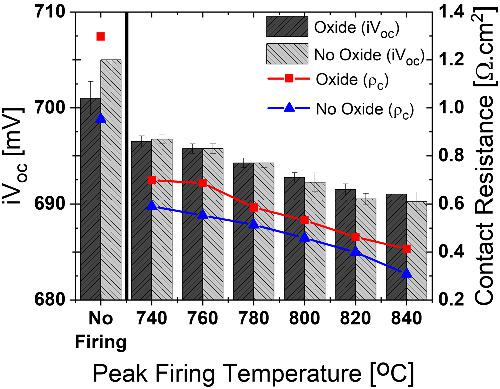当前位置:
X-MOL 学术
›
Prog. Photovoltaics
›
论文详情
Our official English website, www.x-mol.net, welcomes your feedback! (Note: you will need to create a separate account there.)
Thermally stable poly-Si tunnel junctions enabling next-generation high-efficiency Si solar cells
Progress in Photovoltaics ( IF 6.7 ) Pub Date : 2021-08-31 , DOI: 10.1002/pip.3462 Xin Ren Ng 1, 2 , Donny Lai 1 , Puqun Wang 1 , Armin G. Aberle 1, 3 , Rolf Stangl 1 , Fen Lin 1
Progress in Photovoltaics ( IF 6.7 ) Pub Date : 2021-08-31 , DOI: 10.1002/pip.3462 Xin Ren Ng 1, 2 , Donny Lai 1 , Puqun Wang 1 , Armin G. Aberle 1, 3 , Rolf Stangl 1 , Fen Lin 1
Affiliation

|
We demonstrate thermally stable polysilicon (poly-Si)-based tunnel junctions (TJs), that is, n+-poly-Si/p+-poly-Si/SiOx and n+-poly-Si/SiOx/p+-poly-Si/SiOx, for passivating a silicon wafer, selectively extracting holes, and being compatible with the high-temperature firing process of screen-printed metal contacts. An additional interfacial oxide between the n+-poly-Si and p+-poly-Si layers enhances thermal stability and acts as a barrier layer to mitigate dopant interdiffusion between the adjacent poly-Si layers, without significantly increasing the contact resistance. The TJ's thermal stability is investigated by analysing the TJ recombination current density J0 and effective contact resistance ρc after high-temperature firing (740°C to 840°C) of nonmetallised samples. We evaluate two different TJ applications via efficiency potential calculations: (1) When the TJ is applied on the front side of a passivated-contact Si bottom cell for 2-terminal tandem cells, a calculated add-on efficiency of 9.9% for the Si bottom-cell can be achieved with the inclusion of the interfacial oxide; (2) to enable conventional metal screen-printing on a p+-poly-Si layer, the TJ is applied on the rear side of a single-junction Si solar cell, giving a calculated cell efficiency potential of 23.6% at 1-Sun condition. For such a configuration, in the absence of an interfacial oxide between the adjacent poly-Si layers, the cell efficiency potential improves with peak firing temperature. In summary, we successfully develop thermally stable hole-extracting TJs for the two aforementioned applications that are fully compatible with existing industrial silicon solar cell fabrication processes.
中文翻译:

热稳定的多晶硅隧道结使下一代高效硅太阳能电池成为可能
我们展示了基于热稳定多晶硅 (poly-Si) 的隧道结 (TJ),即n + -poly-Si/ p + -poly-Si/SiO x和n + -poly-Si/SiO x / p + -poly-Si/SiO x,用于钝化硅片,选择性提取空穴,并与丝网印刷金属触点的高温烧制工艺兼容。n + -poly-Si 和p +之间的附加界面氧化物-poly-Si 层增强了热稳定性并充当阻挡层以减轻相邻 poly-Si 层之间的掺杂剂相互扩散,而不会显着增加接触电阻。通过分析非金属化样品在高温烧制(740°C 至 840°C)后的 TJ 复合电流密度 J 0和有效接触电阻 ρ c来研究 TJ 的热稳定性。我们通过效率潜力计算评估两种不同的 TJ 应用:(1) 当 TJ 应用于 2 端子串联电池的钝化接触 Si 底部电池的正面时,Si 的计算附加效率为 9.9%可以通过包含界面氧化物来实现底部电池;(2) 在p上启用传统的金属丝网印刷+ -poly-Si 层,TJ 应用于单结 Si 太阳能电池的背面,在 1-Sun 条件下计算出的电池效率潜力为 23.6%。对于这样的配置,在相邻多晶硅层之间不存在界面氧化物的情况下,电池效率潜力随着峰值烧制温度而提高。总之,我们成功地为上述两个应用开发了热稳定的空穴提取 TJ,这些应用与现有的工业硅太阳能电池制造工艺完全兼容。
更新日期:2021-08-31
中文翻译:

热稳定的多晶硅隧道结使下一代高效硅太阳能电池成为可能
我们展示了基于热稳定多晶硅 (poly-Si) 的隧道结 (TJ),即n + -poly-Si/ p + -poly-Si/SiO x和n + -poly-Si/SiO x / p + -poly-Si/SiO x,用于钝化硅片,选择性提取空穴,并与丝网印刷金属触点的高温烧制工艺兼容。n + -poly-Si 和p +之间的附加界面氧化物-poly-Si 层增强了热稳定性并充当阻挡层以减轻相邻 poly-Si 层之间的掺杂剂相互扩散,而不会显着增加接触电阻。通过分析非金属化样品在高温烧制(740°C 至 840°C)后的 TJ 复合电流密度 J 0和有效接触电阻 ρ c来研究 TJ 的热稳定性。我们通过效率潜力计算评估两种不同的 TJ 应用:(1) 当 TJ 应用于 2 端子串联电池的钝化接触 Si 底部电池的正面时,Si 的计算附加效率为 9.9%可以通过包含界面氧化物来实现底部电池;(2) 在p上启用传统的金属丝网印刷+ -poly-Si 层,TJ 应用于单结 Si 太阳能电池的背面,在 1-Sun 条件下计算出的电池效率潜力为 23.6%。对于这样的配置,在相邻多晶硅层之间不存在界面氧化物的情况下,电池效率潜力随着峰值烧制温度而提高。总之,我们成功地为上述两个应用开发了热稳定的空穴提取 TJ,这些应用与现有的工业硅太阳能电池制造工艺完全兼容。


























 京公网安备 11010802027423号
京公网安备 11010802027423号